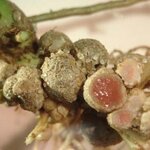Science category landing
Medicine

Extensive death of nerve cells leads to severe dementia in patients with Alzheimer's disease. Until now, it has only been possible to investigate the neuronal devastation in post mortem animal models, and by using complicated methods. Researchers at the German Center for Neurodegenerative Disease at Ludwig-Maximilians-Universitaet (LMU) Muenchen, headed by Professor Christian Haass, have now successfully observed this demise of nerve cells by life imaging. The scientists inserted a gene into zebrafish that leads to a severe form of Alzheimer's in humans. The translucent larvae thereupon…

In 2005 researchers at the University of Gothenburg and Stockholm University discovered a new species of seaweed. The species, which was named Fucus radicans, evolved from a bladder wrack (Fucus vesiculosus) ancestor from the Baltic Sea. Detailed studies of Fucus radicans show that, from an evolutionary perspective, it was formed extremely rapidly: the species was formed less than 2,500 years ago, and probably as recently as about 400 years ago. This discovery is one of few examples of extremely rapid species formation. The results also show that new species can also be formed in the…

An invasion of soybean aphids poses a problem for soybean farmers requiring application of pesticides, but a team of Penn State entomologists thinks a careful choice of nitrogen-fixing bacteria may provide protection against the sucking insects.
Soybeans are legumes, plants that can have a symbiotic relationship with nitrogen-fixing bacteria -- rhizobia -- and therefore do not need additional nitrogen fertilizer. Each type of legume -- peas, beans, lentils, alfalfa -- have their own rhizobia.
"Soybeans are from Asia and so there were originally no nitrogen-fixing bacteria that would…

In May 2008 the island of Guam became a living laboratory for scientists as they attached acoustic equipment to coconut trees in order to listen for rhinoceros beetles. A grant from USDA IPM allowed Richard Mankin, a recognized world-class expert on acoustic detection of insects, to travel to Guam to collaborate with island scientists on the Guam Coconut Rhinoceros Beetle Eradication Project. The results of this research were recently published in the journal Florida Entomologist.
The coconut rhinoceros beetle, Oryctes rhinoceros, is a serious pest of coconut palms and was discovered on Guam…

Individuals with chronic myeloid leukemia (CML) are first treated with a drug known as imatinib mesylate. Although very effective, as the disease progresses it often becomes resistant to the drug. However, a team of researchers, at the University of Leicester, United Kingdom, and Thomas Jefferson University, Philadelphia, has identified a class of drugs that might enhance the therapeutic effects of imatinib mesylate and other drugs that target the same molecule.
The team, led by Paolo Salomoni and Bruno Calabretta, observed that for several different CML cell lines and primary cells, although…

(PHILADELPHIA) The therapeutic effects of the blockbuster leukemia drug imatinib may be enhanced when given along with a drug that inhibits a cell process called autophagy, researchers from the Kimmel Cancer Center at Jefferson reported in the Journal of Clinical Investigation.
The cell-death effect of imatinib (Gleevec) was potentiated when chloroquine, an autophagy inhibitor, was given with imatinib for the in vitro treatment of chronic myeloid leukemia (CML) cells including the CML stem cells, according to Bruno Calabretta, M.D., Ph.D., professor of Cancer Biology at Jefferson Medical…

KINGSTON, R.I. – April 14, 2009 – Most fish rely primarily on their vision to find prey to feed upon, but a University of Rhode Island biologist and her colleagues have demonstrated that a group of African cichlids feeds by using its lateral line sensory system to detect minute vibrations made by prey hidden in the sediments.
The lateral line system is composed of a canal embedded in the scales along the side of the body of a fish, around its eyes and on its lower jaw, which contain small groups of sensory hair cells that respond to water flow. The lateral line system aids some fish in…

Hanover, NH--In a genetic leap that could help fast track vaccine and drug development to prevent or tame serious global diseases, DMS researchers have discovered how to destroy a key DNA pathway in a wily and widespread human parasite. The feat surmounts a major hurdle for targeting genes in Toxoplasma gondii, an infection model whose close relatives are responsible for diseases that include malaria and severe diarrhea.
"This opens a wide window on a complex parasite family and can help accelerate the development of safe and effective genetically modified vaccines and drug therapies," says…

The new study, which was published on April 12, 2009, in an advanced online edition of the journal Nature Structural & Molecular Biology, draws new parallels between the Rad60 DNA repair factor and SUMO, a small ubiquitin-like modifier, which are both essential for maintaining genome stability during replication.
"This collaborative study between our laboratory and the Scripps Research Tainer group shows the very first indication of mimicry in the SUMO pathway," said Scripps Research Assistant Professor Michael "Nick" Boddy, Ph.D., who was senior author of the study. "By mimicking a…

LA JOLLA, Calif., April 13, 2009 -- Investigators at the Burnham Institute for Medical Research (Burnham) have developed a protocol to rapidly differentiate human embryonic stem cells (hESCs) into neural progenitor cells that may be ideal for transplantation. The research, conducted by Alexei Terskikh, Ph.D., and colleagues, outlines a method to create these committed neural precursor cells (C-NPCs) that is replicable, does not produce mutations in the cells and could be useful for clinical applications. The research was published on March 13 in the journal Cell Death and Differentiation.…